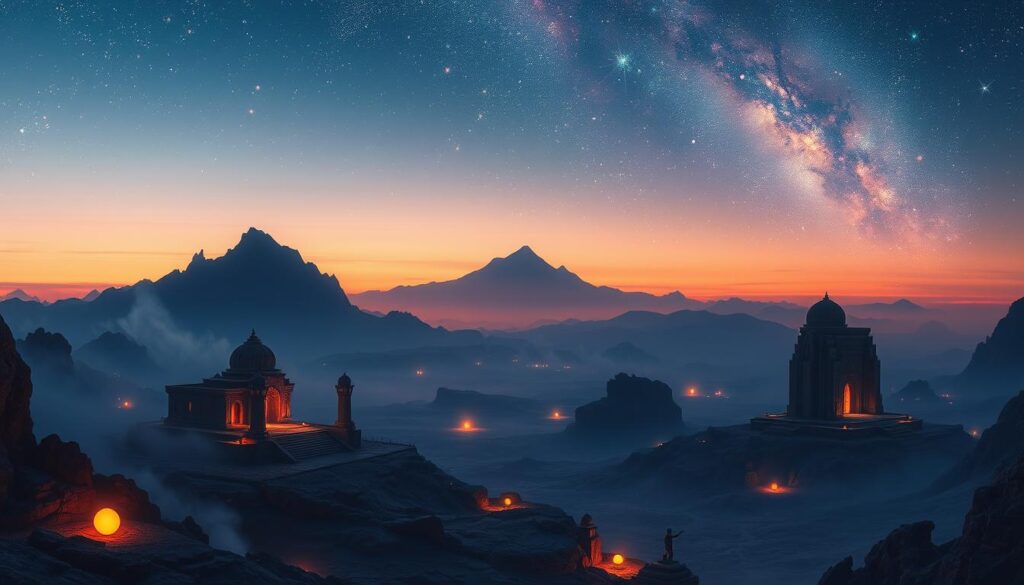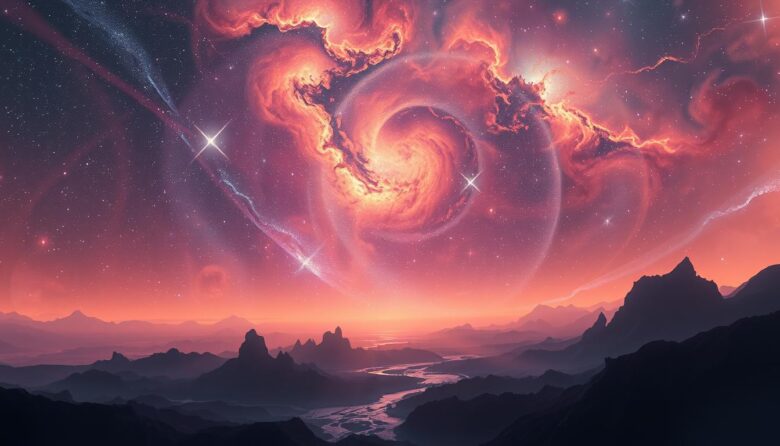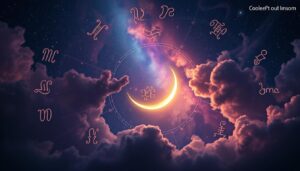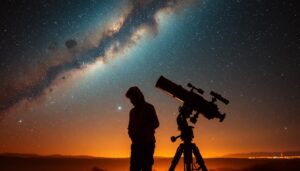Ever woken up with a dream of walking on Mars or floating near Saturn’s rings? You might feel a strange comfort in those places. Scientists and artists are curious about why cosmic scenes evoke such deep emotions.
When night visions feel like home, it’s not just our imagination. Our brains blend memories, fears, and hopes into starry landscapes. Movies like Inception and books like Astronomical show how space stories shape our minds. These dreams might be our way of exploring the unknown while finding peace.
Key Takeaways
- Cosmic dreams mix real emotions with imaginary worlds.
- Sleeping minds use space themes to process daily feelings.
- Sci-fi media influences how we picture other planets in dreams.
- Dreams of distant planets can create a sense of belonging.
- Understanding these visions helps us connect with deeper thoughts.
The Allure of Distant Worlds
Looking up at the night sky, humans have always been drawn to distant planets. These far-off worlds spark our curiosity, mixing reality with fantasy. Dreams of exploring alien landscapes or floating among stars show our deep desire to go beyond Earth.
Why We Dream of Other Planets
Our brains see outer space as a canvas for creativity. Dreams of distant planets often symbolize a longing for adventure or a break from routine. Psychologists say these dreams are like mental playgrounds, where we can imagine life beyond our daily limits.
The Connection Between Dreams and Space
Space’s vastness mirrors our subconscious mind’s endless possibilities. Just as galaxies hold secrets, dreams reveal our hidden thoughts. The darkness of space is like a metaphor for the unknown parts of ourselves we explore every night.
Influences of Sci-Fi on Our Imagination
Culture shapes our dreams. Movies like Interstellar or books like Arrakis in Dune inspire our visions. TV shows like Star Trek make us wonder: What if we could live elsewhere? These stories mix science and myth, making distant planets seem like a place we could visit.
Personal Experiences with Planetary Dreams
Many people have night visions that mix fantasy with reality. Dreams of floating on Mars or walking under twin suns are more than just fantasies. They open a window into our subconscious. Let’s see how these cosmic dreams shape our view of ourselves and the universe.
Collecting Stories of Cosmic Night Visions
At the Sleep and Cognition Lab, researchers looked at 500 dream journals. They found some common themes:
- Astronaut Dreams: 42% described piloting spacecraft or exploring moons
- Alien Landscapes: 31% reported vivid forests of glowing crystals
- Gravity Shifts: 28% recounted floating effortlessly, mirroring real microgravity training
Psychological Insights into Dreaming
Dr. Elena Torres, a sleep psychologist, says: “REM sleep makes emotional memories stronger, turning everyday things into surreal night visions.”
| Common Dream Element | Psychological Explanation |
|---|---|
| Flying through nebulas | Freudian theory: liberation from earthly constraints |
| Alien communication | Reflects social isolation or curiosity about unknowns |
The Intersection of Reality and Imagination
“My Mars dream felt so real I checked astronomy apps afterward,” says engineer James Carter, who later built a rover prototype inspired by his dream.
These stories show how dreams blend facts with creativity. They create a mental escape that’s both personal and universal.
Cultural Perspectives on Dreams and Cosmos

For thousands of years, cultures have linked the wonders of the sky with the secrets of dreams. Stars, planets, and eclipses were seen as messages from the divine. This shaped how people understood their dreams at night.
Mythology and Celestial Bodies
Myths often saw dreams as a way to travel to other worlds. The Norse believed in Yggdrasil, a tree that connected earth and sky. It was thought that dreams allowed souls to journey between these realms.
In Greek stories, Morpheus, the god of sleep, sent dreams through the stars. He made Orion’s belt a bridge between humans and gods.
Ancient Civilizations and Their dreams Interpretations
| Civilization | Celestial Beliefs | Dreams as Omens |
|---|---|---|
| Egyptian | Ra’s nightly voyage across the sky | Prophecies from gods like Thoth |
| Mesoamerican | Venus as the “star that rules fate” | Leaders consulted dreams before wars |
| Indigenous Australian | Stars as ancestral spirits | Dreams revealed land and spiritual laws |
“The sky writes its stories in the language of sleep.” — Babylonian tablet fragment
These traditions show that dreams were more than personal experiences. They were cosmic conversations, guiding actions and uniting people under the stars. Even today, looking up at the stars can connect us to these ancient beliefs, making our dreams a bridge between past and present.
The Science Behind Dreaming
Every night, your brain turns chaos into order, creating worlds that feel both odd and familiar. It’s a home away from home for your subconscious. Scientists study how brain paths make these dream worlds, mixing memories with imagination.
How Dreams Are Formed in Our Minds
- Neurons in the brain’s limbic system spark emotions, while the neocortex arranges these feelings into stories.
- REM sleep amplifies this process, creating vivid visuals from stored experiences and daydreams.
- Areas like the amygdala and hippocampus work together, stitching memories into otherworldly settings.
The Role of REM Sleep in Cosmic Dreams
During REM phases, brainwaves mimic wakefulness, fueling intense dream activity. Studies show people reporting space-themed dreams often enter deeper REM cycles. As Dr. Sara C. Mednick notes in Sleep and Dreaming, “REM’s heightened neural activity may explain why distant planets feel so tangible in our sleep.”
These nightly journeys aren’t random—they’re the brain’s way of testing reality. It blends familiar emotions with unknown frontiers. The result? A mental escape where even alien terrain can feel like a comforting refuge, a home away from home crafted by biology itself.
Interpreting Dreams of Distant Planets
Starting to understand cosmic dreams means spotting patterns. Dreams of floating in starry skies or walking on alien terrain often show our curiosity about space exploration. These visions mix reality with our imagination.
Common Themes and Symbols
Look for these common elements in your cosmic dreams:
- Strange landscapes: Canyons, floating islands, or glowing plants
- Alien communication: Silent gestures or telepathic messages
- Gravity shifts: Falling, floating, or soaring without effort
Tools for Understanding Night Visions
Today, we have tools to make sense of these dreams:
- Journaling: Write down details right after waking
- AI dream analyzers: Apps like DreamMapper find trends
- Online forums: Sites like CosmicDreams.net share insights
| Traditional Methods | Modern Tools |
|---|---|
| Dream dictionaries | AI analysis apps |
| Personal journaling | Online communities |
| Symbolism guides | Virtual reality dream simulators |
Using both old and new methods helps us find deeper meanings. Your dreams might show hopes for discovery or fears of the unknown. Either way, they open a door to understanding our minds and the universe.
Artistic Representations of Planetary Dreams
Sci-fi dreams have always sparked creativity in literature and art. They turn cosmic curiosity into stories and visuals we can all enjoy. Writers and artists help us see these dreams come to life.
Literature Inspired by Cosmic Visions
Books like The Left Hand of Darkness by Ursula K. Le Guin and The Martian Chronicles by Ray Bradbury bring alien worlds to us. They mix human feelings with sci-fi dreams, making far-off planets seem close. Authors use metaphors to reflect real issues, like identity or feeling alone, through their stories.
Art Influenced by Otherworldly Dreams
Artists like H.R. Giger and Chesley Bonestell create alien landscapes with surreal colors and shapes. Giger’s designs for Alien movies mix living and mechanical parts, showing dreams’ strange logic. Painters like Salvador Dalí also mixed reality and fantasy, showing how sci-fi dreams mix imagination and science.
Today, digital artists use AI to make interactive cosmic scenes. These let viewers explore their own sci-fi dreams. Online platforms show these works, proving creativity connects our dreams to the stars.
The Therapeutic Benefits of Cosmic Daydreams
Daydreaming about distant planets is more than just a break. It’s a way to heal emotionally. By imagining interstellar travel, we find a safe space where worries disappear and creativity blooms. These cosmic adventures give us more than just awe; they help us face life’s challenges with a fresh view.
How Dreams Can Help Us Cope with Reality
Getting lost in starry views or drifting through alien air can reset our minds. Studies show that thinking about interstellar travel can reduce anxiety. It shifts our focus away from today’s worries.
Picture yourself walking on Mars or exploring asteroid fields. These fantasies help us see problems from a cosmic perspective. They build our strength. By imagining these scenarios, we learn to face challenges with curiosity, not fear.
Using Dreams for Self-Discovery and Healing
Celestial dreams reflect our inner selves. A therapist might ask: What does your spaceship mean to you? Does navigating a nebula solve a personal problem? These symbols unlock deep emotions.
Writing down your dream details, like the colors of alien skies, can reveal your goals or fears. Even small steps, like meditating on Saturn’s rings, can reconnect us to wonder. This eases our emotional loads.
Connecting with Nature Through Celestial Dreams
Night skies and wild landscapes often blur the line between Earth and the cosmos. When we hike through forests or stand on cliffs overlooking oceans, these moments mirror the curiosity we feel for alien worlds. Nature’s grandeur becomes a bridge to imagining distant planets.
Finding a Sense of Belonging Beyond Earth
Stargazing or exploring remote wilderness can spark dreams of exploration. These dreams aren’t just fantasies—they’re reminders that our planet’s beauty shares patterns with celestial realms. Mountains may echo the craters of Mars, while oceans reflect the vastness of uncharted seas on other planets.
Nature’s Role in Inspiring Cosmic Dreams
Walking through a forest or feeling the rhythm of tides primes the mind to envision alien worlds. Natural elements like auroras or deserts act as gateways to imaginative landscapes. Here’s how nature fuels cosmic visions:
- Landscapes: Canyons and dunes mirror imagined planets.
- Light and shadow: Sunsets and moonlit trails spark curiosity about distant skies.
- Wildlife: Creatures unique to Earth inspire thoughts of extraterrestrial life.
These connections remind us that dreams of space are rooted in Earth’s own wonders. Exploring nature becomes a way to embrace both home and the unknown.
The Future of Dream Exploration
Technology is changing how we see dreams and cosmic visions. Scientists and innovators are creating tools for exploring astral journeys. Imagine exploring a virtual Mars or feeling weightless in space, all while awake.

Advancements in Dream Research
- EEG and AI combine to map dream patterns in real time.
- Studies track how light/sound stimuli influence dream content.
- Universities collaborate with tech firms to decode dream language.
The Potential of Virtual Reality and Space Travel
Virtual reality headsets now let us explore celestial environments. We can “visit” Saturn’s rings or walk on the moon. Companies like SpaceX are making space travel real, inspiring new dreams.
“Dreams are tomorrow’s realities, today,” says Dr. Elena Marquez, neuroscientist at the Sleep Innovation Lab. “VR lets us test these visions in safe, immersive settings.”
Missions to Mars are planned for the 2030s. Our dreams might soon reflect these milestones. A dream of floating in zero gravity could soon be a real experience for astronauts. The sky is no longer the limit.
Creating Your Own Cosmic Dream Journal
Start a cosmic dream journal to explore your dreams. It turns night visions into a map of your mind. Here’s how to get started:
Tips for Recording Your Night Visions
Keep a notebook and flashlight by your bed. Write down every detail as soon as you wake. Include colors, sounds, and emotions.
Look for symbols like alien landscapes or constellations. Review your entries weekly to find patterns or themes.
Exercises to Enhance Your Dream Experience
Before sleep, write down questions like, “What will I see tonight?” This helps focus your mind. Try meditating to clear your thoughts.
Use apps like Sleep Cycle to wake during REM phases. This improves dream recall. With time, you’ll understand your dreams better.
Every note or sketch is a step toward understanding your inner world. Your journal opens a portal to your inner cosmos.



